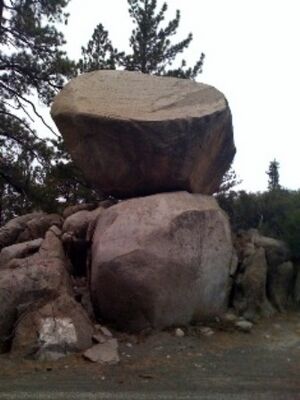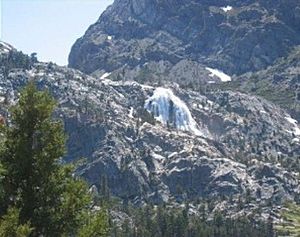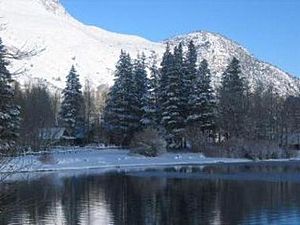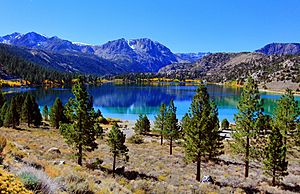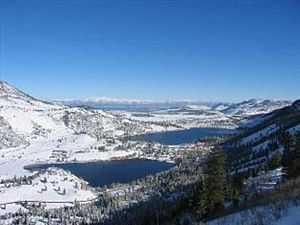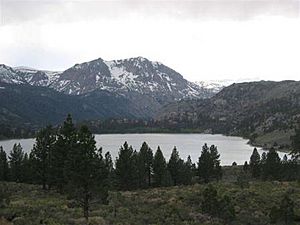June Lake, California facts for kids
Quick facts for kids
June Lake, California
|
|
|---|---|
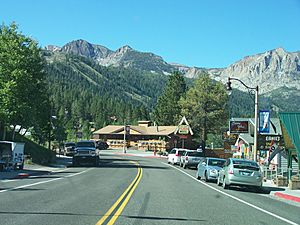
June Lake
|
|
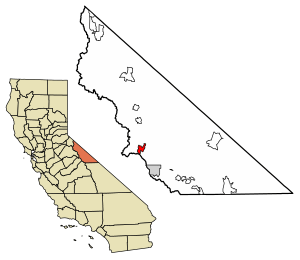
Location in Mono County, California
|
|
| Country | United States |
| State | California |
| County | Mono |
| Area | |
| • Total | 11.10 sq mi (28.74 km2) |
| • Land | 10.31 sq mi (26.69 km2) |
| • Water | 0.79 sq mi (2.05 km2) 7.12% |
| Elevation | 7,786 ft (2,373 m) |
| Population
(2020)
|
|
| • Total | 611 |
| Time zone | UTC-8 (Pacific) |
| • Summer (DST) | UTC-7 (PDT) |
| ZIP code |
93529
|
| Area code(s) | 442/760 |
| GNIS feature ID | 2583044 |
June Lake is a small community in Mono County, California, United States. It's known as a "census-designated place" (CDP), which means it's a specific area the government counts for population. June Lake is located in the southern part of the Mono Basin, about 12.5 miles (20 km) south of Lee Vining.
The main part of June Lake stretches along a five-mile road called the June Lake Loop Road (or State Route 158). This road forms a loop with U.S. Route 395. The official area of June Lake includes the land along State Route 158, from its southern connection with US 395, past June Lake and Gull Lake, all the way to Silver Lake.
In 2020, about 611 people lived in June Lake. However, in the summer, the population can grow a lot! Around 2,500 visitors come to enjoy fishing, camping, hiking, and other outdoor activities.
Contents
Exploring June Lake's Land and Location
The June Lake Loop is nestled against the eastern side of the Sierra Nevada mountains. These mountains form a steep edge to the Great Basin and Range Province. A stream called Rush Creek starts high in the mountains and flows northeast, becoming a major water source for Mono Lake.
How Glaciers Shaped the Valley
The valley where June Lake is located looks like a horseshoe. It was carved out by glaciers long ago. A large glacier, the Rush Creek glacier, split into two parts when it hit a tough rock formation now called Reversed Peak. One part of the glacier flowed north, creating the Rush Creek Canyon. The other part turned south and east. This southern branch was slowed down by hard granite rock and eventually stopped.
When the glacier melted, it left behind a pile of rocky material called a terminal moraine. This moraine is now known as Oh! Ridge. A basin (a bowl-shaped dip in the land) was left west of this ridge. This basin filled with spring water, forming June Lake and the smaller Gull Lake. The water overflowing from these lakes flows back towards the mountains, so it's called Reversed Creek. Reversed Creek then joins Rush Creek, and they flow through Silver Lake and Grant Lake, completing the "loop" back to the Mono Basin.
One cool natural feature is the perched boulder, a huge rock next to the June Lake Fire Station. This boulder is 18 feet (5.5 m) tall and weighs 150 tons! It was carried by the glacier and dropped in its current spot.
Different Areas of June Lake
June Lake has several distinct areas. The main village is between the southwest end of June Lake and the northeast end of Gull Lake. This is the main business area with a post office, community center, library, restaurants, shops, and homes. The West Village/Rodeo Grounds area is north and west of Gull Lake. This area has newer buildings like condos and larger homes.
The June Mountain Ski Area is next to the Rodeo Grounds. It's owned by Mammoth Mountain LLC. Further down the canyon, closer to the Sierra Nevada mountains, are other residential areas and the Rush Creek Power House. These areas mostly have single-family homes, but also some shops and places to stay.
There are also areas leased from the Inyo National Forest, like Pine Cliff Resort and Silver Lake Resort. At the northern end of the Loop road is the Cain Ranch, which belongs to the City of Los Angeles.
The June Lake area covers about 11.1 square miles (29 km2), with 10.3 square miles (27 km2) of land and 0.8 square miles (2.1 km2) of water.
June Lake's Weather
June Lake has warm, mostly dry summers with some thunderstorms in late summer. Winters are cold and snowy. The average monthly temperatures don't go above 71.6 °F (22.0 °C). This type of weather is called a "warm-summer Mediterranean climate."
| Climate data for June Lake, California (1981–2010) | |||||||||||||
|---|---|---|---|---|---|---|---|---|---|---|---|---|---|
| Month | Jan | Feb | Mar | Apr | May | Jun | Jul | Aug | Sep | Oct | Nov | Dec | Year |
| Mean daily maximum °F (°C) | 39.9 (4.4) |
41.0 (5.0) |
45.6 (7.6) |
51.9 (11.1) |
61.6 (16.4) |
70.7 (21.5) |
78.7 (25.9) |
77.7 (25.4) |
70.7 (21.5) |
60.4 (15.8) |
48.5 (9.2) |
41.2 (5.1) |
57.3 (14.1) |
| Mean daily minimum °F (°C) | 12.8 (−10.7) |
14.3 (−9.8) |
19.0 (−7.2) |
24.4 (−4.2) |
31.5 (−0.3) |
38.3 (3.5) |
43.5 (6.4) |
42.4 (5.8) |
35.4 (1.9) |
27.0 (−2.8) |
19.6 (−6.9) |
14.2 (−9.9) |
26.9 (−2.8) |
| Average precipitation inches (mm) | 2.5 (64) |
2.4 (61) |
2.2 (56) |
1.0 (25) |
0.7 (18) |
0.7 (18) |
0.6 (15) |
0.5 (13) |
0.6 (15) |
0.8 (20) |
1.6 (41) |
2.2 (56) |
15.8 (402) |
| Average snowfall inches (cm) | 17.4 (44) |
17.4 (44) |
21.1 (54) |
5.0 (13) |
2.5 (6.4) |
0.5 (1.3) |
0.0 (0.0) |
0.0 (0.0) |
0.5 (1.3) |
2.7 (6.9) |
12.0 (30) |
14.1 (36) |
93.2 (236.9) |
| Source: Bestplaces | |||||||||||||
The History of June Lake
People have been visiting the June Lake Loop for fishing, hunting, and hiking since the late 1800s. The first people to live here were the Paiute Indians of the Mono Basin. Even though there was a lot of mining nearby, people didn't find much gold or silver in June Lake itself. So, the area stayed wild and was valued for its beautiful scenery and fun outdoor activities.
Early Power and Resorts
As mining slowed down, people became interested in a new technology: hydroelectric energy. This is power made from moving water. By 1915, a road was built up Rush Creek. A special rail system was moved from an old mine in Bodie to help build two dams in the mountains. These dams would create hydroelectric power. The Rush Creek Power House started making electricity for distant cities in 1916.
During this construction, an employee named Roy Carson started the first private resort in the Loop, called Carson's Camp. It began as a tent camp and later added cabins. One of these cabins, built in 1921, had a dining room and a small post office. This cabin is still used today as a store and restaurant at the historic Silver Lake Resort.
Around 1924, the U.S. Forest Service built another road from U.S. Highway 395 to June Lake. Power station workers and fishermen extended this road to connect with the one in the Silver Lake area. This new road made it easier for cars to reach June Lake, leading to more development. New housing areas were created between June and Gull Lakes, and near Fern Creek and Silver Lake.
Boulder Lodge was the second resort built on the shore of June Lake. In 1927, the June Lake Lodge (now called the Heidelberg Inn) was built on a hillside overlooking June and Gull Lakes. It opened in 1928 with fifty rooms, a restaurant, and a large fireplace. The Lodge also had a fish hatchery that produced about 1,000,000 small fish each year for the local lakes and creeks. Other camps and lodges, like Gull Lake Lodge and Fern Creek Lodge, also opened.
As more people traveled on Highway 395, a service station called "Crater Garage and Lunch Room" was built at the June Lake Junction. With more people living in June Lake, a Post Office was established in 1927, and the first school opened in 1933.
Hollywood Stars and Water Projects
During this time, car touring became very popular. With the Tioga Pass Road completed, June Lake became a favorite stop for people traveling between Yosemite and Southern California. Many famous people from Los Angeles and Hollywood visited. Film stars Wallace Beery and Raymond Hatton built cabins on Silver Lake. Clark Gable, Charlie Chaplin, Betty Grable, and the Marx Brothers were also guests at the June Lake Lodge. Later, film director Frank Capra and cartoonist Walter Lantz also had cabins at Silver Lake.
Since 1923, the Los Angeles Department of Water and Power had been buying water rights in the Mono Basin to get more water for their aqueduct system. By 1935, the Mono Basin Project was underway. Water from nearby creeks was sent to Rush Creek at Grant Lake, where a large dam was built. An eleven-mile tunnel was dug under the Mono Craters to deliver this water to a new reservoir called Crowley Lake. This big water project was almost finished when World War II began.
During the war, June Lake's population grew a lot. A temporary town was built near the tunnel's East Portal to house workers for the aqueduct project. Many supervisors and contractors also stayed in June Lake.
In 1940, the June Lake Fire District and the United States Forest Service built the first water system for the June Lake Village area.
Skiing and Modern Development
Skiing also became popular in the United States around this time. By 1937, there was a race called the "Silver Skis." Skiers would hike to the top of 10,866-foot Carson Peak and ski back down. In 1940, local business owners started the June Lake Winter Sports Association. They built a 2200-foot rope tow ski area with a 600-foot vertical drop. It offered first aid, ski lessons, and food.
The ski lift was powered by a small private hydroelectric plant because there was no commercial electricity yet. The California Electric Power Company finally brought power lines to the Loop area in 1946. Before that, people used oil lanterns, and they kept food cold by cutting blocks of ice from June Lake in winter and storing them in a large ice house.
The ski area closed during World War II. But in 1958, the Forest Service announced plans for a new ski area at June Mountain. W.C. "Bud" Hayward got the permit and built a full-service ski area with a double chairlift and T-Bar, which opened in 1961. He continued to expand the ski area until 1986.
June Lake remained a busy community through the 1970s, adding a bank, hardware store, and art galleries. However, since then, the nearby Town of Mammoth Lakes has grown a lot, attracting many businesses away from June Lake.
People and Community Life
June Lake's main business is tourism. There are many places to stay, from small cabins to large resorts. There are also public campgrounds in the Inyo National Forest at Oh! Ridge, June Lake, Gull Lake, Reversed Creek, and Silver Lake.
From December to April, the June Mountain Ski Area is the main attraction. It offers over 500 acres of terrain for skiers and snowboarders of all skill levels. The ski resort also has amazing views of the lakes below and the entire Mono Basin. You can rent equipment and take lessons there.
Most jobs in June Lake are in service or retail, like working in shops or restaurants. Some residents also work as builders or electricians. Many people travel to work in nearby towns like Lee Vining, Mammoth Lakes, or even further to Bridgeport or Bishop.
More than half of the homes in June Lake are second homes. Most of these part-time residents visit during the summer, leaving their homes empty in winter. Historically, June Lake's summer residents have played a big role in community life. During winter, most of the workers for the June Mountain Ski Resort live in Mammoth and take a bus to work.
Population Details
The 2010 United States Census counted 629 people in June Lake. Most residents (84.9%) were White, and 12.4% were from other races. About 21.8% of the population was Hispanic or Latino.
Most people (99.7%) lived in homes. There were 290 households. About 19.7% of these households had children under 18. Many households (51.4%) were married couples living together. The average household had 2.16 people.
The population included 18.4% under 18, 6.0% aged 18 to 24, 28.6% aged 25 to 44, 35.8% aged 45 to 64, and 11.1% who were 65 or older. The average age was 41.7 years.
In 2000, June Lake had a population of 613. The population changes a lot with the seasons. While 223 homes are lived in full-time, 571 are part-time residences. Including seasonal visitors, June Lake can have a temporary population of up to 2,900 people.
Fun Things to Do in June Lake
June Lake is often called the "Switzerland of California" because it's built on hills and meadows surrounded by tall mountain peaks. It's famous for its trout fishing.
Hiking is a very popular activity. June Lake has many trails that lead into the Ansel Adams Wilderness Area. Most hikes, like those to Fern Lake, Reversed Peak, and Agnew Lake, are challenging and go uphill a lot. The Parker Lake Trail is an easier 2-mile hike that only climbs 400 feet (120 m) in elevation. The Frontier Pack Train at Silver Lake offers horseback riding trips, including longer trips into the backcountry. In the fall, the many aspen trees turn beautiful gold and red colors as winter approaches.
Education for Kids
June Lake is part of the Eastern Sierra Unified School District. The old June Lake Elementary School was closed and torn down in the 1970s. Now, school buses take children to Lee Vining to attend Lee Vining Elementary School. High school students can go to Lee Vining High School or the Eastern Sierra Academy if they qualify. Some parents also try to send their children to schools in the Mammoth Unified School District. June Lake also has a public library.
Local Services
June Lake Fire Protection District
June Lake is home to the June Lake Fire Protection District, which started in 1939. This district protects an area of about 8.5 square miles (22 km2), including June Lake and nearby areas like Pine Cliff and the June Lake Loop down to Silver Lake. The District has two fire stations.
June Lake Public Utility District
The June Lake Public Utility District was created in 1947. It provides water and sewer services to an area of 1,720 acres (7.0 km2) within the June Lake Loop. The water comes from different sources and is sent through about 47,000 feet (14,000 m) of pipes.
See also
 In Spanish: June Lake para niños
In Spanish: June Lake para niños




